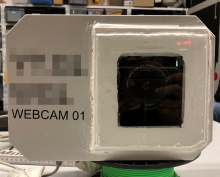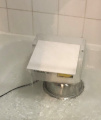Archive:DSLRpi: Difference between revisions
No edit summary |
m Vrs moved page DSLRpi to Archive:DSLRpi without leaving a redirect |
||
(No difference)
| |||
Latest revision as of 15:41, 10 September 2022
| DSLRpi Release status: beta [box doku] | |
|---|---|

| |
| Description | A way to remotely capture pictures with a DSLR. |
| Author(s) | German |
It all started a few month ago with the idea of improving an existing setup on a vineyard located in Franconia.
-
Installation carrying the webcam, directional radio and a netatmo weather station
-
Resulting images during day.
The pictures during daytime were already pretty impressive, but at night you would only see a black screen. Not only annoying but also makes it hard to do nice timelapses. After searching for a while I found Foto-Webcam which runs a remote cam setup that does primarily use Canon EOS 1100D cams. I opted to build the same, however, I wanted to use a raspberry pi and as many standard components as possible.
Hardware
- Canon EOS 1100D
- Dummy-Akku
- 4 Channel Relais Module
- 5V Fan
- Rittal PK Box
- DHT22 Sensor
- PoE Splitter
- Waterproof LAN Connector
Software
- Debian Stretch
- gPhoto2
- Custom scripts for the trigger, most logic is on a remote server
- Custom scripts for backups
- Telegraf to write metrics to an InfluxDB
Features
- PoE Powered (48 V)
- System uses 5V with a peak of 2.5 A
- FAN On/Off via Relais
- Camera hard-reset via Relais
- Fan which blows hot air against the window
- Fully water-proof design (Rain from all directions)
- Temperature monitoring (w/ backup sensors)
- Pole mount
- Plastic shield for rain and sun protection
Cost
The whole setup costs about 350 € in total.
Pictures
Testing & Current Status
I've done some very basic tests in the shower. Stuffed the case with rags and closed it, positioned it and then just sprayed on it from all sides, including shower settings with higher pressure than normal rain would have (probably not even in storm conditions with wind added). The test was successful and I couldn't find any water intrusions.
Because it is going to be put on a pole and modifications are very hard to add in later, I decided to try it on my balcony for a few days. This test was also successful. Now the camera is in Franconia, but not installed on the pole yet. It was installed in a garden temporarily to ensure that it works long-term without any problems. So far so good!
Acknowledgements & Thanks
- Thanks for everyone at the space helping me with the Project
- Special thanks to Rene who helped me with the plot and provided the foil!
- Thanks to Foto-Webcam, even though they removed some of the useful resources










